
BOMBA – The Human Behind The Wall
Art, Art Shouts, Artists, InterviewsZouch Magazine’s Jeff Campagna interviews three major graffiti artists (REN, BOMBA, HOPE) that are featured in the new 484 page photo book “Toronto Graffiti – The Human Behind The Wall“
ZOUCH –How old were you when you painted your first wall and what motivated you to do so?
BOMBA – I painted my first “mural” on a 4ft by 10 ft roll of paper when I was 12, it was a portrait of Che Guevara , with my father for an event in the Chilean community in Toronto, probably around 1981.It was very common to depict our heroes and leaders in large-scale illustrative mural format, not just for events in the Chilean community, but in Latin America as a whole. During the 60s, South America was very much influenced by pop art in the U.S. And traditional mural artist such as Siqueiros and Rivera, creating a very dynamic fusion of popular and political slogans and images which became part of he general aesthetic. My family and I were newcomers to Canada at that time, so our way of participating and contributing to our community was to paint these large scrolls that were often shown during community leaders giving presentations. Many of these events were done in order to maintain solidarity with our people back home, to fundraise as Chile was deep in the midst of a brutal military dictatorship. At the same time, many countries in Latin America were also experiencing human rights violations through their respective governments, so we painted with brother and sisters from : El Salvador,Uruguay, and Argentina.There were many events in thse years, and I recall paiting about 4-5 of those huge scrolls, with : Che Guevara, Violeta Parra, Salvador Allende, and Victor Jara.
That tradition has been somewhat lost now, as not too many organizations or groups exist in Toronto anymore, many disbanded after the military dictatorship in Chile was over. My first actual mural was when I turned 13. My father had been contracted to do a total of 6 walls at a coffeehouse/restaurant, depicting different images from some of Picasso’s paintings of musicians, and so…..my father was my teacher, I learned how to do a grid system (at that time we did not have projectors, so we had to do it old school), how to use fat brushes, skinny brushes, taping and mixing of paint. I was amazed, at that age, that my dad could find so many shades of grey.
Around 94 shades, to be exact. It took us about 3 weeks to complete everything. I began tagging every surface I could in 1986. With fury, and obsession. And I would say,an actual WALL, with a stylized font,and aerosol, it was 1989.
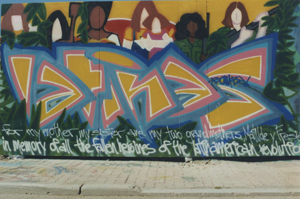
ZOUCH – Does graffiti have a cultural significance beyond that of the obvious artistic merit?
BOMBA – Absolutely. It is the voice of the people in Latin America, In Canada, in Europe. It was the voice during WW1 And WW2. Many graffiti artists used to risk life and limb to get up, in Chile, during those dark years years, denouncing atrocities being committed. It was a very functional process of voicing the truth that was being hidden from mainstream media, which was also controlled by the state. It meant that the graf artists had to be totally trained in every sense of the word in order to get away with their production. And that production was in order to help and support and stand-up. It could cost your life. I was heavily influenced by this process in graf when I look back as to why I thought graffiti was cool. In fact, I thought graf was ONLY for that.
But then I learned that graf was also just a thing of beauty and completely wild freedom, when I started seeing movies depicting full cars…even TRAINS in NYC , circa 1983.At first I found that so….just so crazy and self-indulgent. I remember thinking that those NYC kids were just out of control with their freedom. Remember : I was coming from a brutal military dictatorship where Marshal Law and complete civilian control, censorship on the arts (music ,books visual arts, film were all controlled by the state before even going out to the general public),military raids, incarceration , torture and every other abuse imaginable was allowed, in the name of “eradicating communism”.
When we came to Canada I could not believe how crazy the youth population was, drunk with their freedom, and being irresponsible. So graf in NYC seemed…reckless, and actually safe, as nobody would be persecuted (in my beliefs) to the extent that artists were persecuted back home. And then I saw the book Subway Art, and my attitude changed. Seeing all the work compiled allowed me to understand that it was actually a movement and there were lots of Latinos who were active in their hoods, and their hoods looked…so poor, just like some areas in Chile,and the rest of Latin America, and I began to forge the links in the varying degrees of the NEED for large images that would inspire people, but on a global level.Graf really did open my perception.
I thought it was cool to see a basketball court in the South Bronx all painted up….it would make people wanta ball, I thought, if the court was all done up, and so..I began to respect that work. I also got to hang out with artist such as Galooch (R.I.P.),REN, Kid C, who my brother had introduced me to, and we all used to hang. So certainly being around other like-minded folks influenced my ideas.
To this day, I believe that graf has the power to transform a persons perception of their environment, and it has motivated me to always push for a design that will uplift and empower, or say some truth.

ZOUCH – What separates graffiti from vandalism?
BOMBA – A stylized font letter with images and colors that obviously add to the décor of an otherwise empty,grimey industrial wall, or public access space that is grey and uninspiring is different from a dude writing “AC/DC” or “Led Zep” on my back alley wall. Because then I have to clean that up, as a quick scrawl is not making my day happy.
I actually do not have the definitive answer, as there is a grey line which can be drawn and moved back and forth pending on what politicians feel like persecuting or feel like making money from. Also: bandwagoneers such as for-profit promoters etc. wo want to claim a certain fame,and actually want to profit from the culture can impact decision makers. Sad to say.
I can best explain it, I guess, in my own head by saying this : I go to my dry cleaner around the corner. He is awesome, always friendly, he works with his wife and his son and his son’s wife, well into his 60s, and of Jewish descent. When I showed him our book, he was so happy, as his side wall is part of an alley. In this alley, he allowed a total of 5 graf artists to do up the wall. Beautiful colors etc.Wikkid style. I asked him how come he allowed his wall to be done up. He said : “You know what? For years we had that wall hit up by Nazi skinheads , writing “Jew” and putting up swastikas. Now, I have real art, and no swastikas.” So maybe he could explain better. But I think that maybe hints at a better understanding. I don’t have the definitive answer, it’s a lifetime quest.
ZOUCH – How do the North American reactions to graffiti differ from those of Latin America?
BOMBA – I think if you have consent from the property owner,when you get a wall, the reaction is the same,people are people, and if you work with trust and transparency on somebody’s property, you will have respect, here in Canada or in Latin America. In Chile, my experiences with graf only date back to 2000, when I actually did return to my country and start piecing. I have only done a total of 3 pieces down there, and two were in the hood, Puente Alto, one of Santiago’s first suburb to be developed in the mid 90s.It is middle class, close to he city, but the further you move away, the more you are able to see the intense poverty and decrease in standard of living. I painted in the lower income areas, to make them nicer.I got hugs, smiles,little kids hanging out bringing me candies, little girls asking for autographs, and moms patting me on the back, telling me “thank you”. I had realness I will never forget. And I was in areas where really, maybe it’s not so safe to go there alone at night. In Chile, artists are respected, especially when you donate to the community. People don’t forget. My experience was that property owners would come and bring you a glass of water, some snack or fruit, come talk to you…anything a humble home may have to offer, if they agreed to your painting their wall. It is an exciting event.
Here it has been similar, minus the snack, hospitality is seen a bit different here, it’s a different set of social etiquette , people are more reserved and individualistic, so maybe…they are more shy?I’m still learning Canadians, 30 years later. People are still very jaded here, as they are still very privileged , compared to many developing countries that people have collectively survived war. Also, people in Latin America are more prone to see murals as a work of art done by conscious minds engaged in something positive, while here there is still a tendency to think its a bunch of kids with juvenile criminal tendencies.
I think here in Canada we are much more detached from works of art as our visual landscape in cities really only began with advertising as a whole, we have few precious walls that are done up for the city and that people can access. In Latin America, we have a collective understanding and know of muralists like Diego Rivera and David Siqueiros who’s murals were being done up as far back as the 1920s, decades before either of them became famous in the eyes of U.S. Art critics. We have mural collectives that were active in the 60s, in Chile, namely : the Elmo Catalan brigade, and the Ramona Parra brigade. Both were groups that pushed for artists to be conscious and effective on a community level, but required a level of commitment to design and produce with very little resources. To be a muralist in Chile is to be a REAL artist, even if you are poor.
Here…you are looked at like a delusional crazy person if you don’t do it for the money. Because most of our large scale murals here are ADS FOR PRODUCT. And when you do occasionally see a real nice piece, most people get happy and excited, on a very human level. I always have people who know nothing about the scene come and ask me about the Keele wall, to tell me “wow that is awesome.”Or Graffiti Alley by Queen and Spadina.
Well executed art will always be met with enthusiasm, admiration and respect,universally. That goes for dance, music, photography,etching, film…whatever the discipline.

ZOUCH – As a graffiti artist, what are your views on censorship?
BOMBA – As a survivor of a dictatorship that exerted civilian control on every cultural level, I grew up with songs I could not listen to, with books I could not read, with movies that were not allowed in theaters, …a peoples in complete isolation of any influence that may have been seen as a affront to the established powers is a people without an acknowledgment of their creative voice, and trust that they will become sick. Humans HAVE to imagine and create. Some grandmas do it in the kitchen when they cook. Dads do it when they buy kids their running shoes or their first fishing pole.
I as very very very fortunate two have two amazing parents who valued art and tried their hardest to talk openly and honestly about the works that were censored, to encourage painting and drawing at home, to read poetry, to listen to music. To have your imagination controlled by ANYBODY is, simply put, complete murder of the soul.
As a graf artist you do very very very public pieces. It entails taking yourself into a place that allows you to imagine an image, then you produce it.Big. Only artists,( graf or otherwise), go through this process that entails experimentation with energies , and then committing these to a wall/film/photograph/choreography/song for everybody to feel something. That is the process of ART. And we as artists have to do this, and it’s intense, and it can be so hard on our spirit as we have to go IN THERE, and then produce a product for you to go there with us.
Its a very organic process. Censorship is like….I don’t know, forcing a tree to grow a certain way, or beating an animal into submission…its totally screwed up and I don’t recommend it, it is worse for your health than cancer because it entails power trippin. WHO censors?
Forget that. Please don’t censor anybody, just be pro active if the message impacts you. Be like my dry cleaner!!
ZOUCH – Beyond other artists, what influences you and your work?
BOMBA – Little kids….little kids have become very important to me over time, as they have that skill to tell you what it IS, and you absolutely have to listen at times, as I am convinced they know whats up more than adults…you cannot convince me otherwise. These days, I think about my niece and nephew (6 and 2).They will ask the eternal question: “WHY, tia (auntie), would you put that on the wall?”And I will need to answer with the truth.
For many years,and still to this day, my biggest influence is street culture, all my people struggling in so many different countries, against brutal governments, all my friends living immigration and racism, realities sometimes way beyond my comprehension ,because my mind shuts down after watching so much suffering, and I want to offer images that will cleanse the spirit in simple ways. My dead ones. I want them to feel our love even in the Spirit World.They are not forgotten.
Cities: L.A., San Francisco and New York, Sao Paulo and Santiago, Oaxaca and Lima, Habana and Kingston, Caracas and Buenos Aires…all the places I have performed at, met people at, vibed with. MEXICO : were the masters of giant productions reside. Nature; the Andes mountains with their strong old truth and warrior stance, the forests in B.C. Because the trees really do hold it down. The solar system: most complex math I know to date, my native elders’ prophecies because they tell our real pre-eurocentric-bible truths,and stories from the Mapuche nation before the European invasions. All our First Nations truth. The deserts : San Pedro de Atacama, and Nevada. The world inspires me because it travels through space with all of us. The TRUTH. LOVE. JUSTICE. LOYALTY.
ZOUCH – What gives you sudden inspiration to paint?
BOMBA – Looking for the truth in myself and my history, and hoping to convey that in a way that will make you be active into doing good things for people. Love makes me want to paint. Our time in this dimension is short, so let’s make it count people, lets spend it giving more and more love until everybody is smiling,even the haters. Having access to a wall and knowing I can do whatever I want inspires me.Freedom is the ultimate high.
ZOUCH – What is your ‘dream wall’?
BOMBA – My dream wall…I have many. One whole side of the CN Tower. Two silos by Lake Ontario. I dream of that. Mexico City….any wall with MIBE or UMO.
And the wall I just got funding for, from the Toronto Arts Council which I have been trying to get for 5 years : the southeast wall at Keele and Eglinton West, which will allow me to coordinate with : the West Eglinton BIA (Business Improvement Association), 5 youth from a local youth shelter, local resident youth, and two more experienced aerosol artists .We will make the wall pop and rock for the beginning of the school year. That has been my dream of a wall for the last few years.

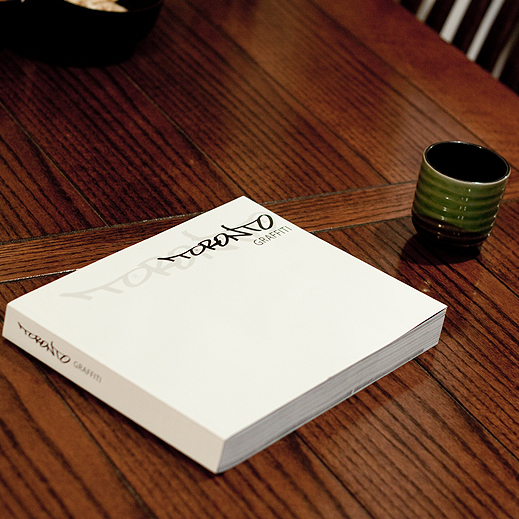
Never before has such a coveted opportunity ever been made available to the general public! If education is power, then “Toronto Graffiti – The Human Behind The Wall” is powerful! This 484-page book of stories showcases 1000+ images which document 30 years of Graffiti in Toronto.
Zouch Magazine’s Jeff Campagna caught up with three major graffiti artists (REN, BOMBA, HOPE) that are featured in the book and asked them some personal and philosophical questions about art, vandalism, spray paint and dreams. Check out the exclusive interviews now.






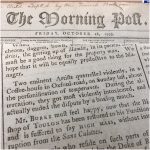






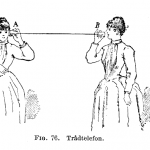




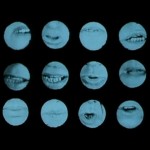




[…] » « .vvqbox { display: block; max-width: 100%; visibility: visible !important; margin: 10px auto; } .vvqbox img { max-width: 100%; height: 100%; } .vvqbox object { max-width: 100%; } // if(document.location.protocol=='http:'){ var Tynt=Tynt||[];Tynt.push('aUGYLs0LSr366Hadbi-bpO');Tynt.i={"ap":"Read More: "}; (function(){var s=document.createElement('script');s.async="async";s.type="text/javascript";s.src='http://tcr.tynt.com/ti.js';var h=document.getElementsByTagName('script')[0];h.parentNode.insertBefore(s,h);})(); } […]